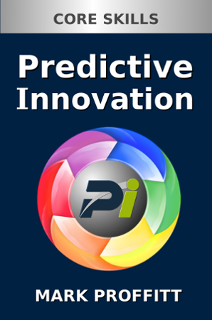Predictive Innovation: Core Skills
Predictive Innovation: Core Skills
 Table of Contents
Table of Contents
Suggestion: Read Problem Solving first, then continue from the beginning of the book.
- Acknowledgments
- Why you need Predictive Innovation®
- Old Way
- New Approach: Predictive Innovation®
- Benefits
- Ways to use Predictive Innovation
- Core Skills
- What
- How
- When
- Where
- Who
- Why
- Get Started
- Overview
- What, How, and Doing it
- What is Innovation
- Ideal Product
- Prerequisites
- Functional Distinctions
- Multidimensional Thinking
- Complexity and Fractals
- Time
- Logic
- Standard Units of Measure
- Exercise
- Dimensions of Predictive Innovation
- Actors
- Desires
- Scenarios
- Outcomes
- Elements
- Alternatives
- Innovation Process
- Exercise
- Basics of Predictive Innovation
- Outcomes
- 7-Elements
- 15-Alternatives
- Alternatives
- Ways to Use the Alternatives Grid
- Scales
- Directions
- Direct
- Indirect
- Stable
- Make Stable
- Return to Stable
- Time and Alternatives
- Combining Scales and Directions
- Example: Paint Sticks to Surface
- Outcomes
- Categories of States
- Outcome Diagram
- Exercise
- Converting Desires into Outcomes
- Emerging Expectations
- More on Outcomes
- Components, Functions, and Outcomes
- Product and Process Improvement
- Complimentary Products
- Exercise
- Primary Elements
- Bicycle Examples
- Chunking
- Elements
- Object
- Begin State
- End State
- Action
- Tools
- Conditions
- Resources
- Element Expansion
- Summary of Element Expansion
- Element Example: Cookies
- Choose Object
- Define Desired End States
- Next Step
- Exercise
- Multiplying Alternatives
- Exercise
- Universal User Process
- Decide to Begin
- Gather Materials
- Prepare Materials
- Confirm It's Ready
- Do It
- Monitor Progress
- Make Adjustments
- Conclude
- Problem Solving
- Solving the Unsolvable
- Dilemma
- Assumptions
- Generalizations
- Inversion
- Exercise
- Example: Learning a Skill
- Elements
- Alternatives
- Example: Bicycle
- Functions
- Elements
- Components
- Combinations
- Innovation Quotient
- Predicting
- Predicting Process
- 1. Diagram Outcomes
- 2. Ideal States
- 3. Functionally Distinct Steps
- 4. Map Steps Covering the Idea Space
- Under-served Outcomes
- Breakthrough vs. Incremental Innovation
- Summary
- Next Step
- Glossary


Comments